-
-
-
-
-
Infrastructure space/
SWARNABH GHOSH:
DMIC
-
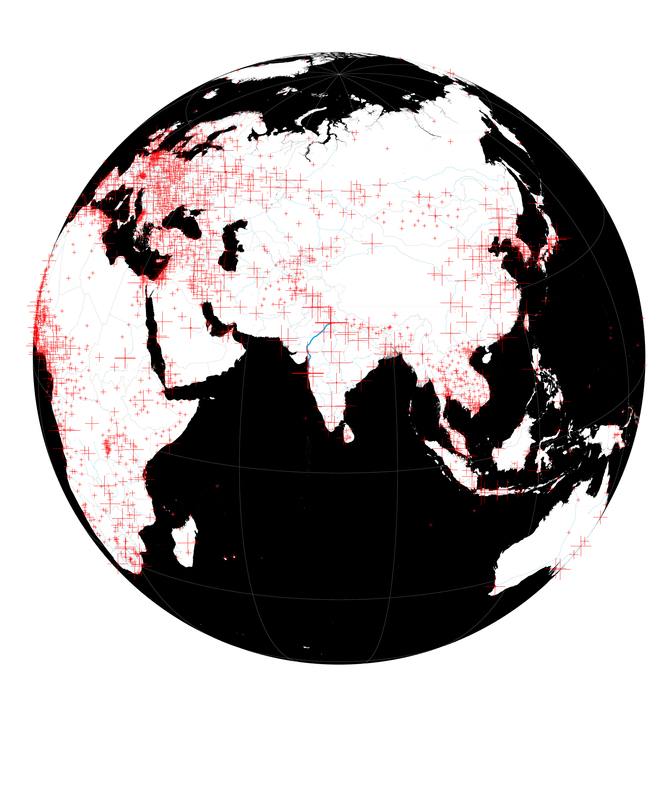
-
DELHI MUMBAI INDUSTRIAL CORRIDOR
When (and if) it is completed, the Delhi Mumbai Industrial Corridor will be the largest and most expensive infrastructure project ever undertaken in the Indian subcontinent. Stretching more than 1480 kilometers between New Delhi and Mumbai, the DMIC, termed a ‘mega-project’ in infrastructural parlance, is projected to cost over 100 billion dollars.
The DMIC comes cloaked in possibilities and aspirations, which not only appear manifold, but in doing so, transcend political, financial and economic ideologies with alarming ease. This project attempts to create a visual cartography of the DMIC - its physical characteristics as well as the variegated relationships between the numerous actors involved in its conception and execution. Perhaps the most challenging aspect of trying to unpack the DMIC is its refusal to present itself as a singular entity despite the deceptively straightforward ‘pyramid’ of players that are responsible for its delivery. In fact, it is this ‘looseness’ which lends the DMIC a specter-like quality, intermittently present in mainstream media and drawing room conversations, but never concrete and rarely instantiated. It is also a great example of a project where a study of facts, numbers, statistics and projections are increasingly futile as they are constantly shifting. Perhaps, this, if anything is its one recognizable quality – a small but steady reformulation of its scope, extent and objectives, brought about by myriad financial, political and economic considerations.
-
networks and connections
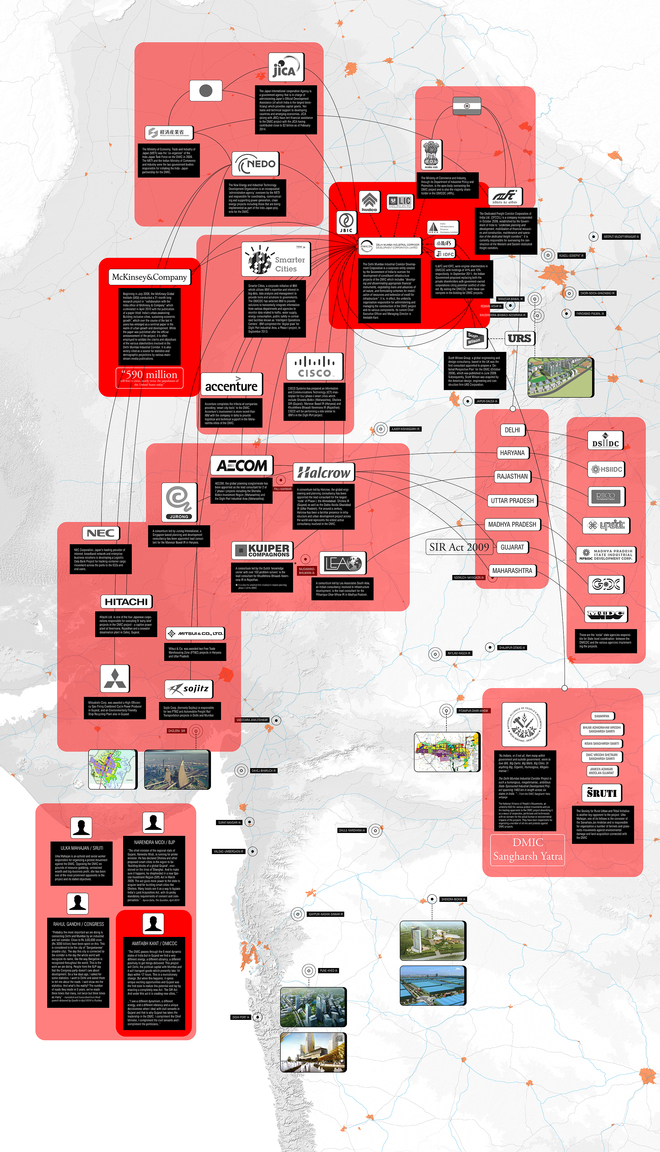
A cartography of actors, institutions and locations.
-
DEDICATED FREIGHT CORRIDOR
The mainstay of the DMIC is a transportation spine that consists of a Dedicated Freight Corridor (DFC). The DFC is a high-speed rail corridor that will radically reduce the time taken for goods to travel from the northern states to the ports on the western coast of the country. The project for the DFC was initiated under the NDA government in 2004 and introduced to the parliament in the 2005-06 session. Japan was brought on board as partner after a series of meetings including the Japan-India Summit in April 2005. To oversee the construction of the dedicated freight corridor(s), a Special Purpose Vehicle (SPV) called the Dedicated Freight Corridor Corporation of India was incorporated in October 2006.
The Delhi Mumbai Industrial Corridor, in many ways a direct and obvious companion to the DFC project, is the most expansive project of planned urbanization after the liberalization reforms of 1991. The first white paper pertaining to the DMIC was published by the Department of Industrial Policy and Promotion of the Ministry of Commerce and Industry in August 2007. The ‘DMIC Concept Paper’ was an ambitious 63-page document that described the objectives of the project and the various stakeholders that were to be directly involved in its implementation. Following the publication of this document, the Government of India, in January 2008 set up the DMIC development Corporation (DMICDC), state-owned corporation that was officially incorporated as the main development agency responsible for the DMIC.
The Government of India held 49% of the stake in the DMICDC while IL&FS and IDFC, private development and financial corporations held the remaining 51 percent. (This arrangement lasted till September 2012 when both private companies were asked to exit due to potential conflict of interest and replaced by State run institutions including HUDCO and LIC).
-
PLANS AND CONSULTANTS
In October 2008, Scott Wilson Group (as of 2010 wholly owned by the URS Corporation), a global engineering and design consultancy was awarded the contract to prepare a ‘Detailed Perspective Plan’, which was published in June 2009. This Perspective Plan was to become the central public document pertaining to the DMIC project. Around the same time Scott Wilson Group was appointed to prepare the Perspective Plan, another familiar global consultancy, McKinsey & Company embarked on a massive research project which culminated in April 2010 with the publication of a paper titled ‘India’s urban awakening: Building inclusive cities, sustaining economic growth.1
The mainstay of the paper is the premise that India is going to urbanize at an incredible pace and its future lies in a steady increase in the number of its cities. It is also curious that the paper, which ostensibly had no connection to the DMIC, presented a series of recommendations that closely mirrored and affirmed the model of urbanization favored by the DMIC namely, “facilitate creation of 25 new world-class satellite cities near the largest metropolitan areas”.2 Moreover, the McKinsey report also recommended that “(the) government should not view these cities as a purely private play, and should become an active facilitator especially in the provision of infrastructure with long lead times such as bulk water, electricity, and trunk-transportation connectivity (i.e., roads and rail)”3 – the objective of the DMIC in the words of McKinsey & Company.
Part economic analysis, part demographic projection and part policy recommendations, this paper has come to occupy a mythical place in the politico-economic realm of India. The ‘McKinsey Report’ often cited by mainstream news organizations when describing infrastructure and urban development, refers in most cases to this 2010 paper. The 590 million ‘urban inhabitants in 2030’ figure is often quoted as fact by corporates, bureaucrats, politicians and journalists alike.
It is another matter altogether that this figure was arrived at as a result of an internal econometric model developed by the McKinsey Global Institute (MGI) to “study the implications of urbanization at the local, state and national levels, and the economic and demographic impact on the 70 largest cities in India.”4 McKinsey tells a very particular story based on its own projections and models and recommends a fairly straightforward approach based on ‘sustainable growth’, ‘smart governance’ and most interestingly, ‘distributed urbanization’. This is not to say that McKinsey favors urban sprawl, a term that it equates with ‘informal’ and ‘unplanned’ urban growth. Instead, ‘distributed urbanization’, as McKinsey describes it, has to do with developing a “diverse range of large and small cities spread widely across the nation.” According to them, this model of urbanization suits India as it is decentralized and balances migration flows.
-
DIST(R)URB
McKinsey’s conception of distributed urbanization falls squarely, if unconsciously, in the middle of urban planning guidelines and public policy recommendations, oscillating between the two and never being one or the other. The report makes a series of common-sense suggestions that include investing in ‘Tier 1’ cities and ‘large Tier 2’ cities, developing and strengthening ‘specialist’ cities, increasing the standards of services in high performing Tier 3 and 4 cities and creating 25 new satellite cities strategically. If one were to go by the recommendations made by McKinsey in its report, the DMIC is well on its way to causing India’s “urban awakening”.
It is tempting and easy to attribute much of the qualities of the DMIC to the post-liberalization, neoliberal paradigm of contemporary Indian politics and economics, however within the DMIC lie a series of narratives, which when examined can lend themselves as useful means to understand and navigate the peculiarities of urbanization in India. The neoliberal qualities of the contemporary Indian politico-economical landscape is often affirmed by scholars and observers but it is important to be mindful of the critical difficulties of using the economic lens of neoliberalization to discuss urban processes in India.
While one of the qualities used to recognize neoliberal capitalism is the abject (and binary) opposition of the State and the Market, “actually existing neoliberalism” as described by Brenner and Theodore,5 presents itself as a more nebulous phenomenon, recalculating, restructuring and reinforcing itself in increasingly non-linear trajectories where the distinction between the “welfare city” and the “neoliberal city” is rendered invisible.6 If one is to adopt the concept of ‘actually existing neoliberalism’ to evaluate the DMIC and its contents, then it increasingly clear that post-reform urbanization in India (including the DMIC) display characteristics that make conventional classifications obsolete as well as ineffectual. While the DMIC cities are envisioned as market oriented urban centers with classification such as ‘industrial areas’ and ‘investment regions’, they are being administered by a centralized State-run development agency (DMICDC) in cooperation with the central government of another country (Japan). This agency is responsible for resource allocation, the preparation of bids and tenders, and general oversight. On the other hand, while the DMICDC is eminently governmental in its ownership, structure and composition, the actual contents of the project, namely the 24 new cities, are predominantly if not solely, based on their viability as investment destinations for global capital.
The first phase of the DMIC which is currently underway will consist of seven ‘nodes’ all but one of which are Investment Regions. Of these, the Dholera Special Investment Region (SIR) in Gujarat is by far the largest exceeding 900 square kilometers. It is also the flagship SIR project of the Gujarat State Government and understandably, the most publicized of all the DMIC cities. In the words of Amitabh Kant, CEO of the DMICDC, “and in words of Amitabh Kant, CEO of the DMICDC, “a completely new Singapore created in the heart of Gujarat”.7 Phase I also introduces characters that will be responsible for the actual work on ground. These include familiar names such as Halcrow and AECOM, both of which are lead consultants for four out of the seven Phase I projects.
-
24 'new' cities
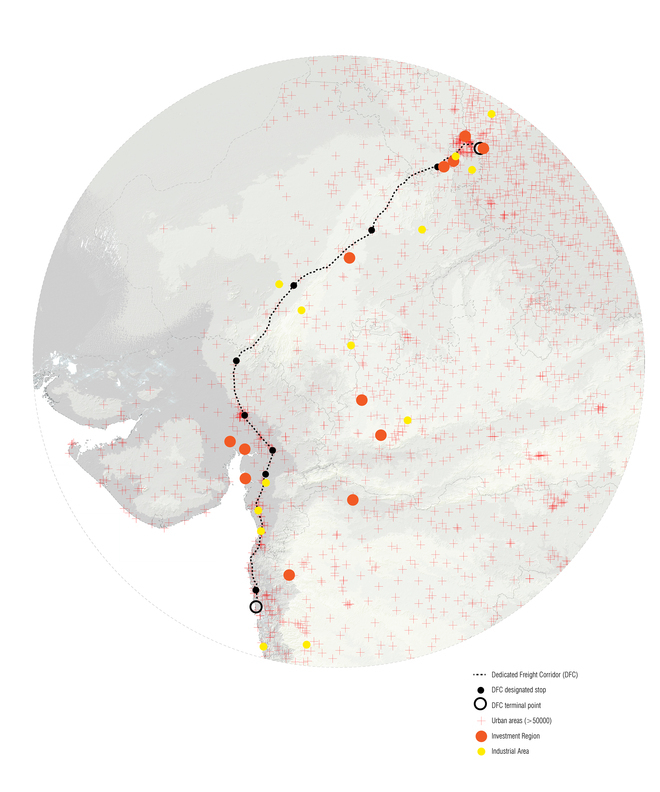
Investment Regions and Industrial Areas
-

Airports and Roads
-
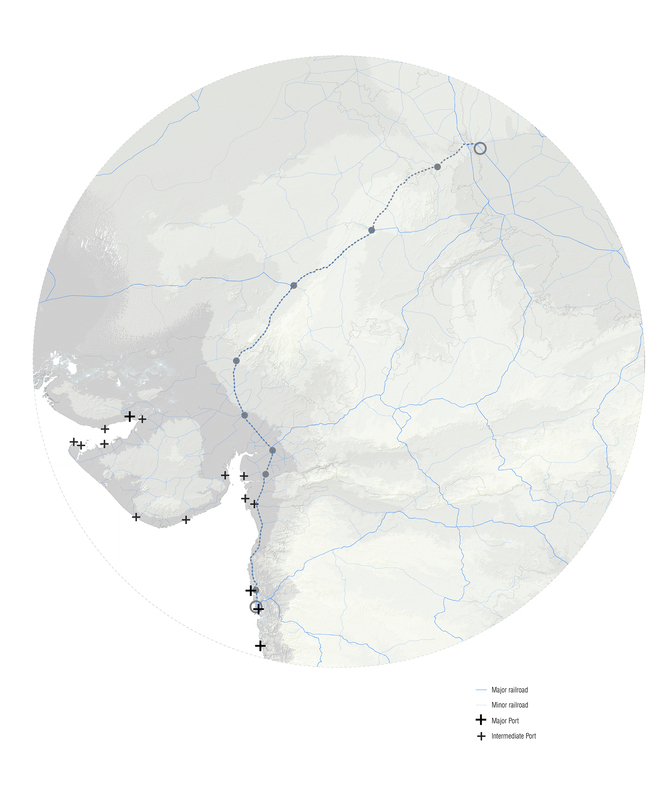
Rail and Ports
-
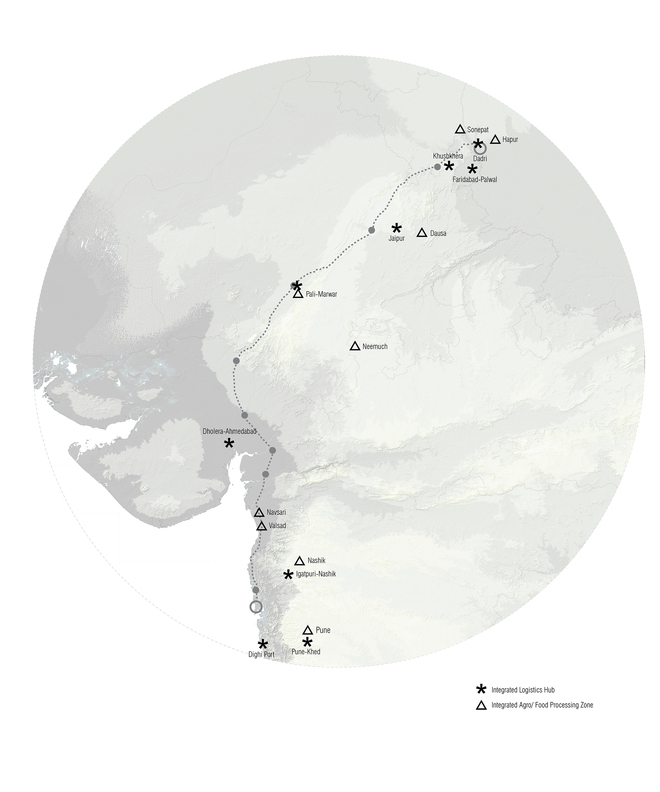
Agro and Logistics Hubs
-
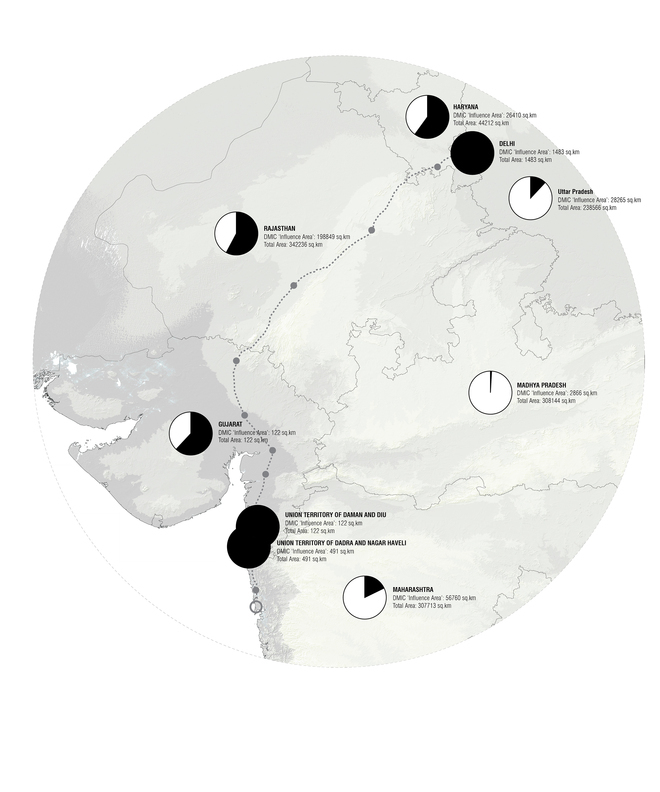
Influence Area by State
-
phase I
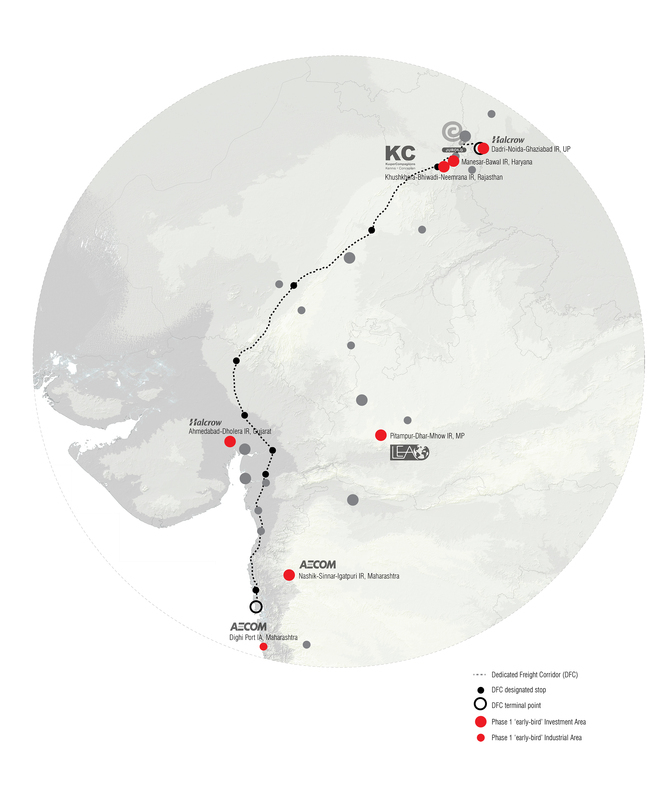
Phase I
-
AFTER NEOLIBERALISM
It is evident that the DMIC presents a blank screen for scholars, economists and political scientists to project onto it, their notions of the combined fallout of global neoliberalization. On the other hand, for architects, urbanists and geographers, the DMIC presents a far more sophisticated problematique – one that enacts and performs an apparently inordinate set of actions that contribute to the overarching goal of ‘decentralized urbanization’. This ‘urbanization’, when gleaned through the twin lenses of the DMICDC and the MGI, appears to be a wholehearted adoption of ‘city-ness’ and ‘urbanity’ at an immense national scale administered through a set of complex public-private models of delivery. There are, of course, many questions. Perhaps the first and most significant question one might ask is - Why and to what end?
While the McKinsey reports provides the ‘theoretical’ and ‘statistical’ foundation for the construction of a limited number of ‘greenfield’ cities, the DMIC seems to circumvent most forms of analysis and conflates projections with proposals, and specific projects with general plans. It uses rehearsed nomenclature that is predominantly programmatic (multi-modal logistics hub, agro-processing plant, desalination plant etc.), and eminently qualititative (sustainable cities, smart cities), and fails to present conceptual exactitude and coherence.
The DMICDC and other purveyors of the DMIC, in their various press releases and statements describe the creation or formation of 24 new cities as central to the projects goals. However, the most important perfomative criterion employed to describe and discuss projects is the ease in facilitation of the flow of global investment and capital. An ‘Investment Region’ as classified by the DMICDC is a “specifically delineated industrial region with a minimum area of over 200 square kilometers while an ‘Industrial Area’ has a minimum area of over 100 square kilometers.8 These “special investment nodes” contain within their extents combinations of food processing zones, industrial parks, business parks and SEZs. Along with actively encouraging the creation of Special Economic Zones, the DMIC makes the setting up of SEZs radically simpler with ‘single window’ clearances and low upfront costs.
The State of Gujarat under its erstwhile Chief Minister Narendra Modi went one step further by enacting in 2009, the Special Investment Region (SIR) Act. According to the Gujarat Infrastructure Development Board, this Act “shows the commitment of the Government to set up world class hubs of economic activity on the lines of fastest growing (sic) countries of the world.”9 This Act further simplifies and smoothens the procedure for setting up special investment nodes (which include SEZs) by creating an Apex Authority empowered to be the “single window system and the first contact for setting up any economic activity or amenity in the SIR”.10 Measures such as the SIR Act have led Amitabh Kant, the CEO of the DMICDC to describe Gujarat as having taken the “leadership in the DMIC.” It is also entirely unsurprising that Government of Gujarat has approved more than 60 SEZs since the announcement of the DMIC project.11
-
Provisional Conclusions
Episodes like the SIR Act make it amply clear that the DMIC might very well be a ‘fast track’ bureaucratic regime to facilitate a constellation of new SEZs and ‘integrated townships’ which will in effect, transform the Western half of India into a container for agglomerations of small and medium sized ‘zone cities’ – a form of SEZ urbanism that will be unprecedented in size and scale. The programmatic logic for the delineation of cities at one scale, suggests the formation of large interconnected regional economies however the empiricist notions of interdependency employed to make decisions make the formation of resource networks improbable at best. At first glance, one might be tempted to believe that the model of urbanization championed by the DMIC is indeed decentralized; however there is little if any clarity to what this might entail. It is here that is becomes useful to employ definitions of urbanization which are rooted in the understanding of the processes of urbanization such as extant politico-economic regimes, logistical and communication networks, ecologies of production and waste – in other words, the vast ‘back stage’, where urbanization is constructed and prepared for performance. It is with this in mind that these maps were prepared. Using a repertoire of data sources including DMICDC documents, this collection of maps is the first step in visualizing – (i) the myriad trajectories and connections between actors and stakeholders (ii) the networks and layers of infrastructures and ecologies at play at regional scale.
The DMIC, undoubtedly a brave experiment in urbanization, raises many more questions than are mentioned in this research project. There are, as this is being written, a constant stream of events unfolding, each of which will have repercussions on the project and its future. From the numerous protest movements rallying against the monumental scale of land acquisition, to an extremely combative general election, the DMIC is a constantly shifting phenomenon and a rich test-bed for ideas related to the future of urbanization in India. In a country with some of the fastest growing urban agglomerations in the world, the DMIC, at a national scale, marks a decided shift in conversation from the rehearsed and repeated dialectics of urban-suburban and center-periphery. On one end of the spectrum of possibilities is the optimistic promise of a project that will produce a decentralized urbanism that relies on the disposition of a linear bundle of hard as well as soft infrastructures, to establish a set of new, as well as nourish a set of existing urban economies in the form of small cities. On the other end, it is entirely possible that the DMIC will devolve into a belt of special investment regions which will house special economic zones – and leave in its wake widespread dispossession, acute disparity, and resource depletion and environmental damage. In both cases, the DMIC will have changed the landscape of India, and it is imperative that we follow it very closely.
-
Notes
1. For details, see “India’s urban awakening: Building inclusive cities, sustaining economic growth”, McKinsey Global Institute (April 2010) available online at: http://www.mckinsey.com/insights/urbanization/urban_awakening_in_india
2. Shirish Sankhe, Irene Vittal, et al., “India’s urban awakening: Building inclusive cities, sustaining economic growth” McKinsey Global Institute (April 2010), 147
3. Sankhe, Vittal et al, 147
4. Sankhe, Vittal et al, 4
5. Neil Brenner and Nik Theodore, “Cities and the Geographies of ‘Actually Existing Neoliberalism’”, Antipode 34:3 (July 2002): 349-379
6. Brenner and Theodore, 375.
7. Amitabh Kant, speech delivered at the Vibrant Gujarat Summit 2013, Gandhinagar, Gujarat (January 2013)
8. For details, see “Concept Paper Delhi Mumbai Industrial Corridor” DIPP, Govt. of India (August 2007).
9. Legal Framework, SIR Act 2009, Gujarat Infrastructure Development Board, n.d. Web < http://www.gidb.org/cms.aspx?content_id=95>
10. ibid
11. Special Economic Zones, Vibrant Gujarat, n.d. Web < http://www.vibrantgujarat.com/special-economic-zones.htm>
-
-
-
-
-
-
-
©2012 The authors and contributors
-